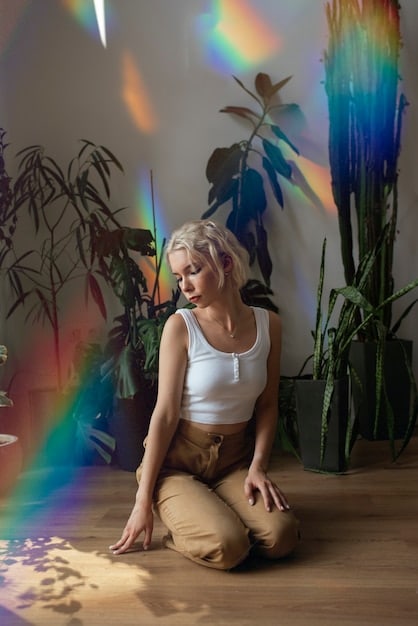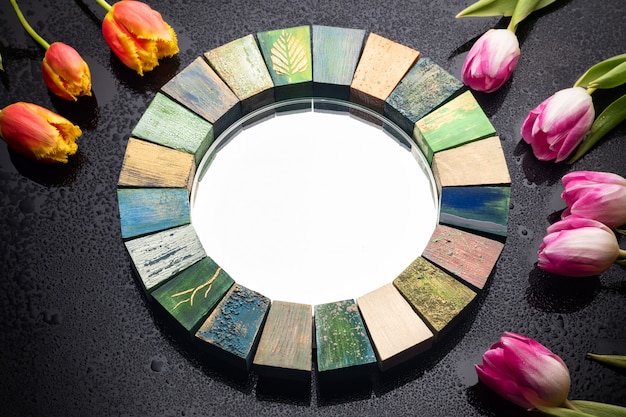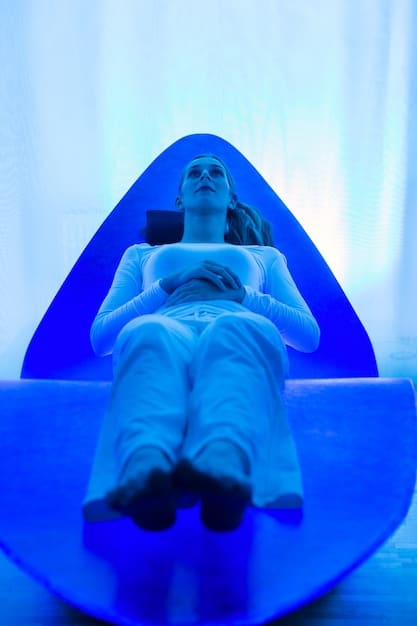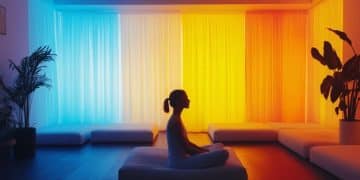Color Meditation: Enhance Mood & Healing with Colors

Color meditation is a powerful technique that involves focusing on specific colors to enhance mood, promote healing, and achieve a greater sense of well-being. It uses the unique vibrational frequencies of colors to influence emotions and energy levels.
Are you looking for a simple yet effective way to boost your mood and promote healing? Color meditation offers a unique approach, harnessing the power of colors to influence your emotions and energy levels, leading to a more balanced and peaceful state of mind.
Understanding Color Meditation
Color meditation is a practice where you focus on specific colors to influence your emotional and physical well-being. This type of meditation leverages the inherent properties of colors to evoke certain feelings and promote healing.
Each color is associated with different emotions and energy centers within the body. By visualizing or surrounding yourself with certain colors, you can tap into their unique vibrational frequencies to enhance your mood and promote healing.

The Science Behind Color and Emotion
The idea that colors can influence our emotions isn’t just based on folklore; there’s a growing body of research supporting this connection. Colors are essentially wavelengths of electromagnetic energy, and these wavelengths can have a direct impact on our physiological and psychological states.
For example, studies have shown that blue light can have a calming effect, while red light can be stimulating. By consciously using color in meditation, we can leverage these effects to our advantage.
Benefits of Color Meditation
- Improved mood and emotional balance
- Reduced stress and anxiety
- Enhanced focus and concentration
- Promotion of physical healing
- Increased self-awareness
In summary, color meditation is a practical method to improve overall wellness by utilizing the connection between colours and human emotions, creating a sense of balance and promoting healing through focused meditation practices.
How to Practice Color Meditation
Engaging in color meditation can be simple and integrated into your daily routine. It involves creating a calm environment and choosing a color that resonates with your current needs or goals.
Whether you are a beginner or an experienced meditator, there are many ways to easily incorporate color into your practice to greatly enhance relaxation and focus.
Setting the Stage
To begin, find a quiet and comfortable space where you won’t be disturbed with soft lighting. You may use candles, incense, or essential oils to create a relaxing atmosphere. Sit or lie down in a comfortable position, close your eyes, and take a few deep breaths to center yourself.
Choosing Your Color
Select a color that aligns with your intention. For example, if you’re seeking calmness, choose blue or green. If you need energy, opt for red or orange. Allow your intuition to guide you in selecting the most appropriate color for your needs.

Visualization Techniques
There are several visualization techniques you can use during color meditation. Try imagining the color filling your entire being, starting from your toes and moving up to the crown of your head. Visualize the color surrounding you like a protective shield or enveloping you in a warm embrace. Focus on the sensations and emotions that the color evokes.
- Breathing the color in and out
- Visualizing objects of the chosen color
- Focusing on a colored object or image
- Surrounding yourself with colored light
In conclusion, color meditation requires setting up a proper environment, choosing a color, and using visualisation techniques to enhance focus and relaxation, thus enabling you to connect deeply with the chosen colors.
The Meaning of Colors in Meditation
Each color possesses unique properties and associations that can influence your meditation experience. Understanding these can help you choose the right color for your specific needs and goals.
Each color carries its own vibrational frequency and symbolism, offering specific benefits and emotional associations that can deepen experiences during meditation sessions.
Red: Energy and Vitality
Red is associated with energy, vitality, and passion. It can be used to boost your energy levels, increase motivation, and stimulate action. Red may also help with physical healing and circulation.
Blue: Calm and Peace
Blue is known for its calming and peaceful properties. It can help reduce stress and anxiety, lower blood pressure, and promote relaxation. Blue is also associated with communication and intuition.
Green: Healing and Balance
Green is the color of healing, balance, and growth. It can help harmonize your emotions, promote physical healing, and connect you with nature. Green is also associated with compassion and empathy.
- Yellow: Joy and Optimism
- Orange: Creativity and Enthusiasm
- Violet: Spirituality and Intuition
In short, each color in meditation serves a different purpose; thus, understanding the unique properties of these colors can significantly enhance the efficacy of color meditation, aligning mental and physical states.
Integrating Color Meditation into Your Daily Life
Color meditation doesn’t have to be limited to formal meditation sessions. There are many ways you can integrate it into your daily life to enjoy its benefits throughout the day.
By incorporating color techniques into everyday activities, you can consistently foster feelings of calm, energy, and overall wellness, enhancing the effects of meditation.
Color in Your Environment
Surround yourself with colors that resonate with you. Decorate your home or office with colors that promote the mood you desire. Wear clothing in colors that make you feel good. Use colored lighting to create a specific atmosphere.
Color-Infused Activities
Engage in activities that incorporate color. Spend time in nature, surrounded by the greens and blues of the natural world. Visit an art museum and immerse yourself in the colors of the paintings. Create your own art using colored pencils, paints, or crayons.
Mindful Color Observation
Pay attention to the colors around you throughout the day. Notice the color of the sky, the flowers in your garden, or the food on your plate. Take a moment to appreciate the beauty and energy of each color. By consciously observing colors, you can deepen your connection to their unique properties.
- Use color-coded organizers
- Drink water from a blue glass to promote calmness
- Eat colorful fruits and vegetables
In conclusion, integrating color meditation into your daily life involves surrounding yourself with appropriate colours, actively participating in colour-infused activities and mindfully observing those colours to maintain a continuous sense of balance and promoting overall well-being.
Advanced Techniques in Color Meditation
For those with more experience, several advanced techniques can deepen your color meditation practice. These techniques involve working more intentionally with the subtle energies of colors.
Advanced Colour Meditation enhances practice through focused awareness, energy work, and combining colours, thus allowing a deeper mind-body connection and improve healing by exploring the transformative powers of colour.
Chakra Color Meditation
Each of the seven chakras, or energy centers, in the body is associated with a specific color. By focusing on these colors during meditation, you can balance and harmonize your chakras, promoting optimal health and well-being. Visualize each chakra spinning and glowing with its corresponding color. Use affirmations to reinforce the healing process.
Combining Colors
Experiment with combining colors to create new effects. For example, combining blue and green can promote both calmness and healing. Combining red and yellow can boost both energy and joy. Allow your intuition to guide you in selecting the most effective color combinations.
Working with Colored Light
Use colored light therapy to enhance your meditation practice. Shine a colored light onto your body or into your meditation space. Experiment with different colors to determine which ones have the most profound effect on you. Colored light can intensify the emotional and physical benefits of color meditation.
- Visualizing colored mandalas
- Meditating with colored crystals
- Using colored candles to set intentions
In summary, advanced colour meditation involves more complex techniques such as Chakra work. This method can deepen the effect of meditation by promoting harmony, boosting energy, and deepening connection with the subtle nuances of colours to improve overall well-being.
Troubleshooting Your Color Meditation Practice
As with any meditation practice, you may encounter challenges along the way. Addressing these challenges can help you deepen your practice and experience greater benefits.
In order to address the potential obstacles and improve your colour meditation results, it’s important to troubleshoot and refine your approach.
Difficulty Visualizing
If you have difficulty visualizing colors, don’t worry. Visualization is a skill that improves with practice. Start by focusing on a real object of the color you’re trying to visualize. Close your eyes and try to recreate the image in your mind. With practice, you’ll find it easier to visualize colors.
Distracting Thoughts
It’s normal to have distracting thoughts during meditation. When your mind wanders, gently bring your attention back to the color you’re focusing on. Don’t judge yourself for having distracting thoughts; simply acknowledge them and let them go.
Emotional Blockages
Sometimes, certain colors may evoke uncomfortable emotions. If this happens, acknowledge the emotion without judgment. Allow yourself to feel the emotion fully, and then release it. You may also want to work with a therapist or counselor to address any underlying emotional issues.
- Experiment with different colors
- Adjust your meditation environment
- Seek guidance from an experienced teacher
In conclusion, overcoming the hurdles in your colour meditation practice involves identifying and addressing visualisation challenges, managing distracting opinions, and recognizing emotional blocks in order to refine your technique and improve your overall results.
| Key Point | Brief Description |
|---|---|
| 🧘♀️ Basics of Color Meditation | Focuses on using colors to influence emotions and energy. |
| 🌈 Color Meanings | Each color has unique effects, like red for energy and blue for calm. |
| 💡 Integration Tips | Surround yourself with colors in your environment and activities. |
| ✨ Advanced Techniques | Chakra color meditation and combining colors enhance the practice. |
Frequently Asked Questions About Color Meditation
▼
The primary goal is to enhance emotional and physical well-being by using the vibrational frequencies of colors to influence mood, promote healing, and create a sense of balance and harmony.
▼
Choose a color that aligns with your intention or current needs. For example, blue for calmness, red for energy, or green for healing. Trust your intuition to guide you in selecting the most appropriate color.
▼
Yes, color meditation can promote physical healing by leveraging the specific properties of colors to influence the body’s energy centers, reduce stress, and enhance the body’s natural healing processes.
▼
You can practice color meditation as often as you like, even daily. Start with shorter sessions and gradually increase the duration as you become more comfortable with the practice.
▼
If you have difficulty visualizing colors, start by focusing on real objects of the color you’re trying to visualize. Practice regularly, and your visualization skills will improve over time. Be patient and persistent.
Conclusion
Color meditation offers a simple yet powerful way to enhance your well-being by harnessing the unique properties of colors. Whether you seek calmness, energy, or healing, incorporating color into your meditation can deepen your practice and bring greater balance to your life.





